A Coupled Method of Laplace Transform and Legendre Wavelets for Lane-Emden-Type Differential Equations
Abstract
A coupled method of Laplace transform and Legendre wavelets is presented to obtain exact solutions of Lane-Emden-type equations. By employing properties of Laplace transform, a new operator is first introduced and then its Legendre wavelets operational matrix is derived to convert the Lane-Emden equations into a system of algebraic equations. Block pulse functions are used to calculate the Legendre wavelets coefficient matrices of the nonlinear terms. The results show that the proposed method is very effective and easy to implement.
1. Introduction
The solution of the Lane-Emden equations is numerically challenging due to the singularity behavior at the origin and nonlinearities. Therefore, much attention has been paid to searching for the better and more efficient methods for determining a solution, approximate or exact, analytical or numerical, to the Lane-Emden equations. The existing methods fall into two groups: the analytical methods and the numerical ones. The analytical methods express the exact solution of the equation in the form of elementary functions and convergent function series, such as the Adomian decomposition method (ADM) [4–7], homotopy perturbation method (HPM) [8–10], variational iteration method (VIM) [11–13], homotopy analysis method (HAM) [14, 15], power series solution [16], and differential transformation method [17, 18]. Unlike the analytical methods, the numerical ones approximate the exact solution on a finite set of distinct points, such as the Legendre Tau method [19] and sinc-collocation method [20], Lagrangian approach [21], successive linearization method [22], wavelets and collocation method [23–26], and spectral method [27].
The Laplace transform is a wonderful tool for solving linear differential equations and has enjoyed much success in this realm. However, it is totally incapable of handling nonlinear equations because of the difficulties caused by nonlinear terms. Since Laplace Adomian decomposition method (LADM) was proposed by Khuri [28] and then developed by Khan [29] and Khan and Gondal [30], the couple methods that based on Laplace transform and other methods have received considerable attention in the literature. What is more, the homotopy perturbation method [31] and the variational iteration method [32] are combined with the well-known Laplace transform to develop a highly effective technique for handling many nonlinear problems. For example, the coupled methods [33–38] based on the homotopy perturbation method and Laplace transform have been proved to be very effective for the solution of nonlinear problems.
Wavelets theory, as a relatively new and emerging area in mathematical research, has received considerable attention in dealing with various problems of dynamic systems. The fundamental idea of this technique is that it reduces these problems to those of solving a system of algebraic equations, thus greatly simplifies the problem and reduces the computation cost [6]. Moreover, wavelets establish a connection with fast numerical algorithms. Yousefi [25] has obtained the numerical solutions of the Lane-Emden equations (1.1) by converting it into an integral equation and then using Legendre wavelets and Gaussian integration method. Furthermore, Pandey et al. [26] obtained the numerical solutions of Lane-Emden equations by using the operational matrix of derivative of the Legendre polynomials.
Motivated and inspired by the ongoing research in these areas, we propose a coupled method of Laplace transform and Legendre wavelets to establish exact solutions of (1.1). The advantage of our method is its capability of combining the two powerful methods to obtain exact solutions of nonlinear equations. The remainder of the paper is organized as follows. In Section 2, we describe some preliminaries about Legendre wavelets and Block function pulses. The proposed method is detailed in Section 3. Four examples are given in Section 4 to demonstrate the validity and applicability of the proposed method. Finally the concluding remarks are given in Section 5.
2. Preliminaries
2.1. Legendre Wavelets
2.2. Block Pulse Functions
- (1)
Disjointness: the BPFs are disjoined with each other in the interval t ∈ [0, T):
()for i, j = 1,2, …, m. - (2)
Orthogonality: the BPFs are orthogonal with each other in the interval t ∈ [0, T):
()for i, j = 1,2, …, m. - (3)
Completeness: the BPFs set is complete when m approaches infinity. This means that for every f ∈ L2([0, T)), when m approaches to the infinity, Parseval’s identity holds:
()where()
Definition 2.1. Let A and B are two vectors of m; then .
Lemma 2.2. Assuming f(t) and g(t) are two absolutely integrable functions, which can be expanded in block pulse function as f(t) = FB(t) and g(t) = GB(t) respectively, then one has
Proof. By using the property of BPFs in (2.11), we have
2.3. Nonlinear Term Approximately
The operational matrix of product of Legendre wavelets can be obtained by using the properties of BPFs. Let f(t) and g(t) be two absolutely integrable functions, which can be expanded in Legendre wavelets as f(t) = FTΨ(t) and g(t) = GTΨ(t), respectively.
3. Laplace Legendre Wavelets Method (LLWM)
In this section, we will briefly demonstrate the utilization of the LLWM for solving the Lane-Emden equations given in (1.1).
Now, we will show how to derive the Legendre wavelets operational matrix of operator Π. First of all, three corollaries are given.
Corollary 3.1. Let Ψ(x) be the one-dimensional Legendre wavelets vector defined in (2.6), then one has
Proof. Let ; then by expanding Ψ(x) by Φ(x), we obtain
From (3.9), we obtain
Corollary 3.2. Let Ψ(x) be the one-dimensional Legendre wavelets vector defined in (2.6), then one has
Proof. From the definition of operator Π, we can know
By further analysis, we obtain
So we finally have
Corollary 3.3. Let Ψ(x) be the one dimension Legendre wavelets vector defined in (2.6); then one has
4. Numerical Examples
In this section, four different examples are examined to demonstrate the effectiveness and high accuracy of the LLWM.
Example 4.1. Consider the lane-Emden equation given in [6]
Applying the method proposed in Section 3, we have
When k = 1 and M = 5, the numerical solution and the absolute error of Example 4.1 are plotted in Figure 1. We see that a good approximation is obtained by using a few terms of Legendre wavelets.
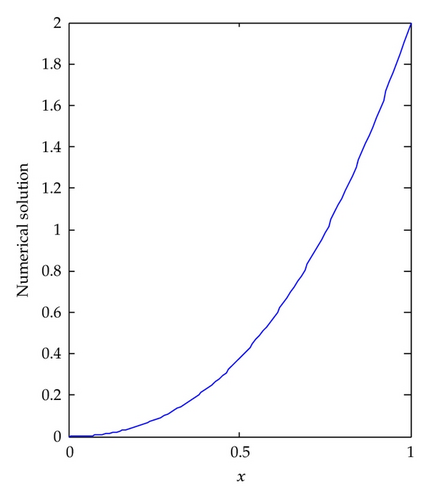
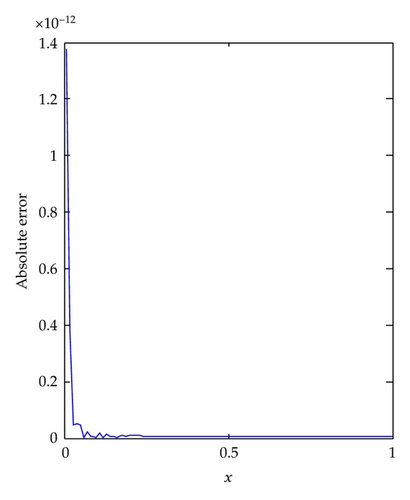
Example 4.2. Consider the lane-Emden equation of index n:
Applying the method developed in Section 3, we have
From [18], we can get the four terms approximate solution of (4.4) as follows:
In the case of n = 1, when k = 1 and M = 11, the results of Example 4.2 are plotted in Figure 2. We observe that the accuracy of LLWM solution is very high. For the case of n = 5, which has strong nonlinearity, we plot the results when k = 1 and M = 16 in Figure 3. It can be noted that the LLWM solution is very close to the exact solution. In addition, we give the numerical solutions of difference n in Figure 4.
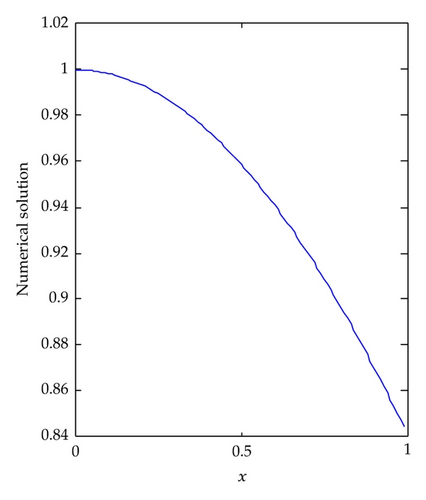
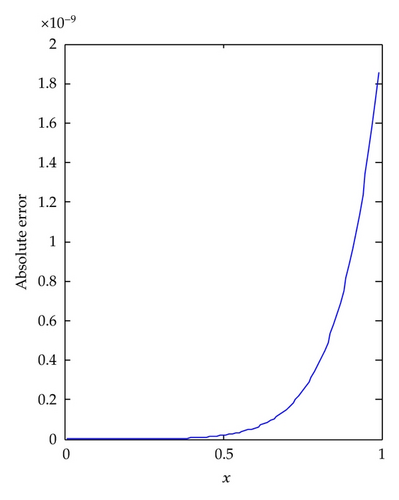
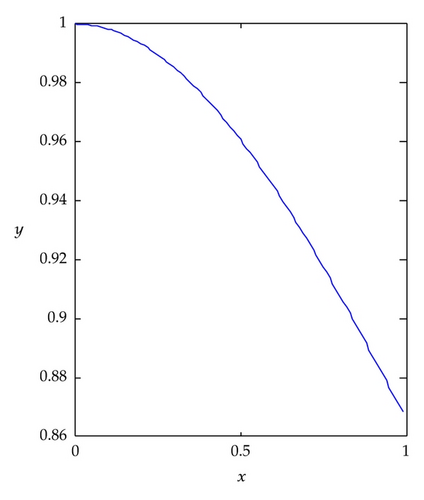
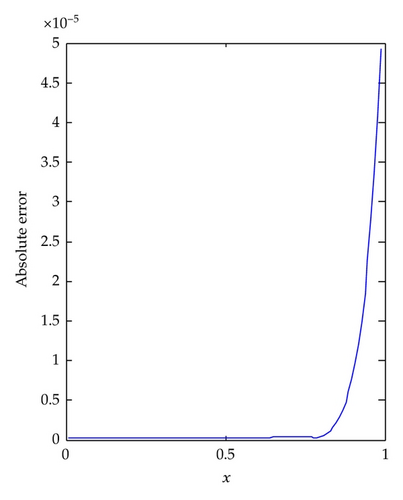
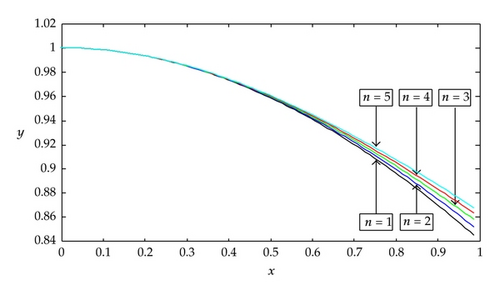
Example 4.3. Consider the Lane-Emden equation given in [7] by
Applying the method developed in Section 3, we have
When k = 1 and M = 9, the numerical solution and the absolute error of Example 4.3 are plotted in Figure 5. We observe that the accuracy of LLWM is very high and only needs a few terms of Legendre wavelets.
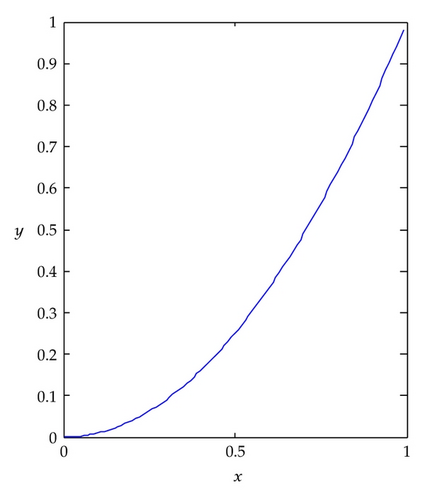
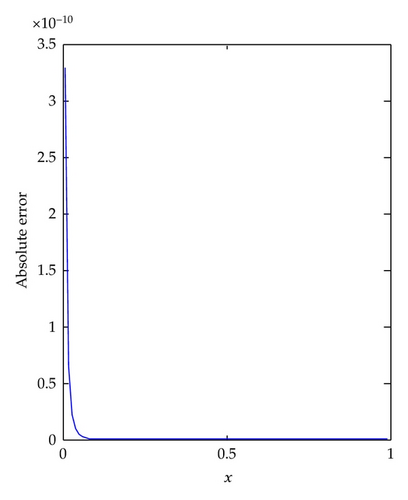
Example 4.4. Consider the following nonlinear Lane-Emden differential equation [7, 8, 13]:
Here, we first expand f(x, y) = 4(2ey + ey/2) by Taylor series and then have
Considering only the first five terms we can write
We let g(x) = 12x and then approximate g(x) and f(x, y) − g(x) by the Legendre wavelets as
By applying the LLWM, we have
The analytical methods, such as the ADM [7], HPM [8], and VIM [13], can get the exact solution of Example 4.4. From [7, 8, 13], we can know that the four-term solution of the above methods is y(x) = −2(x2 − (1/2)x4 + (1/3)x6 − (1/4)x8).
When k = 1 and M = 9, the numerical solutions of Example 4.4 are plotted in Figure 6. We observe that the LLWM solution is more accurate than the four-term solution of HPM or ADM or VIM. The LLWM can only get the approximate solution because of the error caused by expanding the nonlinear term. However, the LLWM can avoid the symbolic computation and only needs a few terms of Legendre wavelets. Since the exact solution is an analytic function, the higher accuracy can be obtained by taking M > 9.
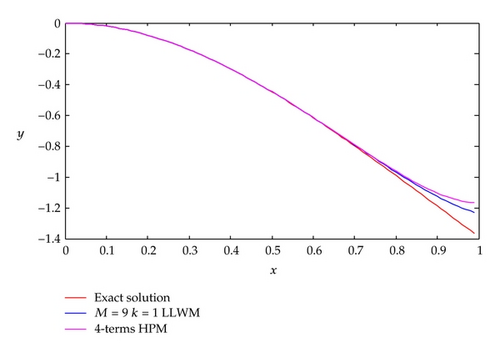
5. Conclusion
In this paper, we have successfully developed a coupled method of Laplace transform and Legendre wavelets (LLWM) for solution of Lane-Emden equations. The advantage of our method is that only small size operational matrix is required to provide the solution at high accuracy. It can be clearly seen in the paper that the proposed method works well even in the case of high nonlinearity. Compared to the analytical methods, such as the ADM, VIM, and HPM, the LLWM can only get the approximate solution because of the error caused by expanding highly nonlinear terms. However, the developed vector-matrix form makes LLWM a promising tool for Lane-Emden-type equations, because LLWM is computer-oriented and can use many existing fast algorithms to reduce the computational cost.
Acknowledgments
This work is supported by National Natural Science Foundation of China (Grant no. 41105063). The authors are very grateful to reviewers for carefully reading the paper and for his (her) comments and suggestions which have improved the paper.




